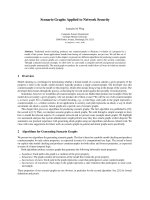Global Software Development handbook auerbach series on applied software engineering series pot
Bạn đang xem bản rút gọn của tài liệu. Xem và tải ngay bản đầy đủ của tài liệu tại đây (253.21 KB, 12 trang )
9
Chapter 2
Critical Success Factors
for Global Software
Development
John works for BAS Corporation, which grew over years through mergers
and acquisitions of companies around the world. BAS Corporation wants to
consolidate the disparate products from its different companies into a single
product line to simplify new product development and achieve economies
of scale. John is asked to spearhead this effort. Although he has managed
many challenging projects successfully, John has never worked on one that
involved coordinating the efforts of development teams from multiple sites
around the world. He begins to wonder how his approach to this project
would be different from managing a single-site collocated project.
In the age of global economy, many of us are finding ourselves in a
similar situation for perhaps a different reason. Labor rates are currently
low in Eastern European nations, Brazil, India, and China, and there could
be cost savings if development is outsourced to these regions. A company
may have expertise in a set of technologies or a domain, thus making it
attractive for partnership. Shortage of staff and time-to-market pressures
may force an organization to carry out parallel development using a
workforce from around the world.
This chapter looks at issues of concern in global software development
(GSD) projects and provides factors that are critical to the success of such
projects. In addition, it begins to describe a process framework for how
AU9384_book.fm Page 9 Thursday, August 17, 2006 1:09 PM
10 Ⅲ Global Software Development Handbook
one might realize these critical success factors. The overview in this chapter
serves as a road map for the details that follow in subsequent chapters.
2.1 Issues
When organizations initially get involved with GSD, they often drastically
underestimate the impact of using geographically distributed teams. One
reason for this is that the extent to which people in collocated environ-
ments rely on ad hoc and informal communications to develop software
is under-recognized. The impact of not having this informal communica-
tion and not accounting for its absence is often quite disastrous. The
authors have seen this play out time and time again in failed projects
from many different organizations.
Based on these experiences, a number of factors critical to the success
of a GSD project have been identified. These factors are admittedly high-
level and do not in and of themselves adequately convey the intuition born
of years of experience. To help explain how these critical success factors
can be operationalized, we have developed a process framework to illustrate
a process that embodies these factors. This is not meant to suggest that this
process framework is a solution for everybody. A one-size-fits-all solution
does not exist. Rather, it is meant to further explain and demonstrate how
these critical success factors can be realized in a GSD project.
2.2 Critical Success Factors
This section discusses the critical success factors for GSD projects. While
these factors are useful for all projects, the business case and necessity is
much greater when projects are geographically distributed across several
time zones with many remote teams having no history of ever working
together, compounded by language and culture differences. These factors
are meant to embody experience from many such projects (and thus very
abstract). How these factors are realized in any given project depends on
many things, such as the organizational processes, the characteristics of the
teams, the organizational structures, and the system to be built. Implement-
ing these success factors must be seen as an investment that pays off in
risk mitigation and quality. In the remainder of this book we give examples
and guidance for how to account for these factors in your projects.
2.2.1 Reduce Ambiguity
While it is desirable to reduce ambiguity for all aspects of any project, a
lot of uncertainty and ambiguity gets addressed in collocated projects
AU9384_book.fm Page 10 Thursday, August 17, 2006 1:09 PM
Critical Success Factors for Global Software Development Ⅲ 11
through informal communication. GSD projects do not have the same
luxury. Ambiguity leads to assumptions. These assumptions are not readily
apparent to the powers that be, and therefore conflicting assumptions can
exist for quite some time before they manifest themselves as problems.
These problems lead to re-planning, redesign, and rework. All of these
are difficult to execute in a distributed environment. Coordination can be
slow, arduous, and ineffective. The impact of having to do these coordi-
nation-intensive activities can cause long delays, leave teams idle and
frustrated, cause quality problems, and have (on more than one occasion)
caused a project to be stopped.
These ambiguities can be with respect to the organizational processes,
the management practices, the requirements, or the design. Combined
with a lack of experience and domain knowledge in the teams, the
situation can get even more complex. Therefore, much thought and work
should go into establishing conventions for how different teams work
together to ensure that they extract the intended meaning from project
artifacts. Processes should have clearly defined rules of engagement,
requirements should be modeled so they are easily understood, architec-
ture should be elaborated with dependencies among modules identified
and components specified with well-defined interfaces, work packages
should be created for individual teams with clearly stipulated task assign-
ments, and, above all when communication occurs between teams to seek
some clarification, one must ensure that answers to questions are correctly
understood.
What is a clear articulation to one team with a particular background
and culture may very well not be clear to another. Mechanisms for verifying
that particular aspects of the project are understood, training programs,
or personnel swapping may be required. Staffing should be done carefully
to balance technology experience and domain knowledge. The particular
characteristics of a project are going to govern the amount of ambiguity
that the project can deal with as well as the appropriate mechanism for
addressing this ambiguity. For example, if a sponsoring organization has
been involved with a long-term relationship with remote teams, likely
there is an established working culture that makes it easier to communicate
particular aspects of the project, versus two teams that have never before
met or worked together.
2.2.2 Maximize Stability
Instability has an influence on many aspects of a project. Agile processes,
for example, are a response to unclear and unstable requirements. Some
of the major tenets of agility strive to create an environment that optimizes
the amount of ad hoc and informal communication (e.g., pair programming,
AU9384_book.fm Page 11 Thursday, August 17, 2006 1:09 PM
12 Ⅲ Global Software Development Handbook
working in a collocated space, on-site customer representatives, short
iterations, daily stand-up meetings, etc.). It makes sense then that in
distributed projects, where these types of communications are difficult,
stability is a factor. The impact of having unstable aspects of the project
is similar to that of having ambiguous areas in your project.
What does this mean, however? Well, again, it largely depends on the
particulars of the project, but it may mean that one must delay initiation
of the development phase beyond that of typical collocated projects to
allow the specification of requirements and design to further stabilize.
Change requests are a major risk to GSD projects as they need 2.4 times
longer to resolve in distributed environments as compared to collocated
projects (Herbsleb and Mockus, 2003). Therefore, the need for excellent
requirements engineering and architecture cannot be underemphasized.
It may mean that additional prototypes are developed, UI mock-ups are
designed, frameworks are developed, or development environments are
customized. There are many ways in which the stability of various aspects
of the project could be increased. We will give examples and talk more
about how this can be done later in the book.
2.2.3 Understand Dependencies
The interdependencies between tasks imply the volume, frequency, and
type of coordination needed among the participants in a GSD project. It
is critical for planning and execution of the project to have a handle on
what coordination needs are likely. Typically, the dependencies are
thought of as a “calls relationship” among the subsystems that are to be
distributed. While such a relationship does imply a dependency, there are
many other aspects to consider as well. From a technical perspective there
are many factors that may imply coordination. For example, if there is a
hard latency requirement, that could imply some coordination between
all the teams involved in developing code that could execute concurrently;
or, if one team is responsible for developing a subsystem that requires a
complex image processing algorithm, there may be an increased need for
coordination.
The technical aspects of the project are not the only sources of depen-
dencies, however. There are many temporal dependencies that stem from
the planning or staging of the implementation. For example, implementation
might be distributed by development phases or by complete modules or
subsystems allocated to different development sites. The latter can be much
more advantageous than the former. We go into some detail about how to
identify these dependencies and how to account for them in your project.
AU9384_book.fm Page 12 Thursday, August 17, 2006 1:09 PM
Critical Success Factors for Global Software Development Ⅲ 13
2.2.4 Facilitate Coordination
The complement to understanding the interdependent nature of the tasks is
to facilitate the corresponding coordination. It must be the case that the
teams that need to coordinate are able to do so in a way that is commensurate
with the need. There are many different ways in which teams can coordinate.
While this is usually thought of strictly in terms of communication, it is much
broader than that. Communication is one way in which teams can coordinate,
but they can also coordinate via processes, management practices, and
product line architectures, to name a few. These choices can be seen as a
trade-off between overhead and risk. For example, if an organization were
to design and develop a framework that would constrain the design and
implementation choices of a remote team, while enforcing the remote team’s
compliance with the original intent of the team, the cost of building such a
framework, however, is quite high. The framework would also eliminate the
need to communicate the embodied design decisions in other ways.
In our experience, it is often the case that GSD projects put too much
emphasis on cost reduction by moving some of their development to low-
cost sites. Little attention, if any, is given to investing in improving the process
and development environment that could automate to some degree and
guide to a great extent the coordination efforts of the collaborating teams.
It is not always clear up-front, however, what the need is or how well
a given solution would work in a given environment, so it is often wise
to have back-up strategies in place if things go awry.
2.2.5 Balance Flexibility and Rigidity
In many ways the practices of GSD projects should be both more flexible
and more rigid than their collocated counterparts. Remote teams often have
different backgrounds, different development processes, different experi-
ence levels, different domain knowledge, different cultures, and in some
cases different organizational practices. The overall development process
should be flexible enough to accommodate these differences. This may
mean giving the remote teams some freedom in adopting a more agile
internal development process. The process, however, also should be more
structured and rigid in a particular way. It must be rigid enough to ensure
that particular aspects of the project are well defined and the processes
followed as the normal safety nets are in place, for things such as instructions
are understood, architectures are complied with, requirements are achieved,
configuration management (CM) processes are adequately defined, integra-
tion and test procedures are appropriate, etc. This is necessary to monitor
progress, ensure that deadlines are met, and guarantee quality.
AU9384_book.fm Page 13 Thursday, August 17, 2006 1:09 PM
14 Ⅲ Global Software Development Handbook
2.3 A Process Framework
Figure 2.1 shows a process framework for GSD. It is not the intent here
to describe a rigorous process that every project should follow. Rather, to
more easily introduce the concepts found within this book and demonstrate
how the critical success factors can be realized, a high-level process
framework with steps that project teams are likely to follow is described.
This is not intended to be a one-size-fits-all process. While we have used
this process in practice, it usually requires tailoring and adoption for the
given context. The activities within this framework are shown as sequential
steps covering the areas of requirements, architecture, project planning,
and product development, but in practice these steps will be highly iterative.
The goal of the requirements engineering step of the process is to gain
a good understanding of the requirements so one knows what is it that
one is trying to build, and to identify the driving requirements — those
that are architecturally significant and have the most value to the business
for which the system is being built. We use model-driven requirements
engineering (Berenbach, 2003, 2004a, 2004b)
that uses the Unified Mod-
eling Language (UML) to specify the requirements. UML as a specification
does not provide any guidance on how it must be used; we have, through
our research, developed approaches that leverage UML’s ability to add
meaning to the links among the requirements, thus making them easier
to analyze for completeness, consistency, and quality as well as allow for
automated tracing to design models and tests.
While model-driven requirements engineering is a systematic develop-
ment and maintenance of detailed product requirements that begins when
Figure 2.1 A process framework for GSD.
Process Framework
Requirements Engineering
Architecture Design
Project Planning
Product Development
Project Plan
Product
Architecture
and Module
Specifications
Requirements
Specification
Business
Goals
Legacy
Systems
Market Intent/Product Vision
AU9384_book.fm Page 14 Thursday, August 17, 2006 1:09 PM
Critical Success Factors for Global Software Development Ⅲ 15
a project has gained enough momentum, there is a need early in the
project to develop a business case, define a product, and gather customer
requirements. This can be accomplished through prototyping and story-
boarding (Song et al., 2005). To discover key architecture-relevant require-
ments, their interactions with other project requirements, and formulate
strategies to address any resulting conflicts, we use a technique called
Global Analysis (Hofmeister et al., 2000).
For globally distributed software development projects, model-driven
requirements engineering offers several benefits that help overcome some
of the issues related to communication, coordination, and control. Visual
modeling aids comprehension and communication among distributed
teams. Tool support for evaluating the models gives on demand a measure
of size, progress, consistency, completeness, and quality. Most significantly,
however, UML models can support automated traceability; modeled
requirements can be traced forward to their corresponding design and
tests, and backward to the market intent, stakeholder requests, and busi-
ness goals. This can help with requirements coverage (i.e., what require-
ments have been implemented in a given release) and impact analysis
(i.e., what is the impact of a requirement change).
The focus of the architecture design step is to get a detailed under-
standing of the architecturally significant requirements and create an
executable architecture. Many software development methodologies treat
architecture only indirectly or implicitly. The quality of systems developed
using such methodologies thus depends largely on the skill level and
experience of its architect. We use architecture-centric methods
(Bass et
al., 2003) such as the Quality Attribute Workshop (QAW), Attribute Driven
Design (ADD), and the Architecture Tradeoff Analysis Method (ATAM),
which provide explicit and methodical guidance to an architect in creating
systems with desirable qualities. The QAW uses stakeholders early in the
software development life cycle to discover the quality attribute require-
ments that drive the structure of a system; ADD uses these requirements
to design the architecture; and the ATAM helps stakeholders understand
the consequences once an architecture for a system has been determined.
The project manager uses the requirements specification and the archi-
tecture and module specifications to generate a project plan to implement
the new product (Paulish, 2002). The project manager performs risk
analyses, defines proposed project strategies, does incremental release
planning, and generates a proposed development plan describing how
and when the product should be developed. Estimation methods are used
to determine the effort and schedule to implement the product.
In the product development step, the application modules are designed,
implemented, tested, and integrated to produce intermediate product
releases, some of which are beta tested at the customer site. This eventually
AU9384_book.fm Page 15 Thursday, August 17, 2006 1:09 PM
16 Ⅲ Global Software Development Handbook
produces a product baseline mature enough to be deployed in the user
community.
The organization of product solution development is optimized using
small, distributed module development teams synchronized by a central
organization. The development teams worldwide receive module specifica-
tions from the central team. Each team, led by a supplier manager, is respon-
sible for the design, implementation, and testing of the assigned module. In
our experience, the role of the supplier manager is often not sufficiently
defined and implemented but is a key role in our approach (see Chapter 10).
In keeping with the best practices of agile methodologies, these teams
carry out iterative implementation of their modules in small increments
using test-first development. Tests to exercise module interfaces are pro-
vided by the architecture team because these tests not only help verify
the modules, but also help developers understand the semantics of the
interfaces much more clearly (Simons, 2002). The modules are designed
using known design patterns and refactored on a continuous basis to
maintain their quality (Fowler, 2004).
2.4 Development Phases and Decision Points
We use a phased product planning process. Like the standard Rational
Unified Process (RUP), it has four significant stages in the software
development life cycle (Arlow and Neustadt, 2002; Larman, 2005). The
inception phase is the visionary milestone phase wherein the problem to
be solved and its potential solutions are investigated to determine the
feasibility of the project. Once considered feasible, the project enters into
the elaboration phase. This is the core architecture milestone phase
wherein requirements are prioritized and those deemed architecturally
significant are implemented first. At the end of the elaboration phase, a
more reliable software development plan is put into place and the con-
struction phase of the software begins. This phase is the operational
capability milestone phase because at the end of this phase the software
is deployed in the production environment of one or more beta customers
to demonstrate its operational capability. Once operational, the software
moves to the transition phase. This is the product release milestone phase,
as the software product is now generally available in the market.
Tip: Make offshore members a part of the central team
in the early phases of the project.
A number of requirements and architecture related
activities require collaboration to impart domain and
AU9384_book.fm Page 16 Thursday, August 17, 2006 1:09 PM
Critical Success Factors for Global Software Development Ⅲ 17
architecture expertise to the offshore teams. It is advisable
in the inception and elaboration phases to involve mem-
bers of the offshore teams so they begin to gain an under-
standing of the domain and the architectural vision. These
members can then be relocated to their home sites when
the construction phase begins and act as local experts.
Furthermore, we suggest that these key members of the
offshore teams be relocated to the central site with their
families. This minimizes home-sickness, and provides
local support as “culture shock” issues arise.
These phases span over multiple iterations, each iteration leading to an
executable release of a fraction of the complete product. The number of
iterations in the phases and their duration will depend on the size of the
project. We use Scrum techniques (Schwaber, 2004; Schwaber and Beedle,
2001), and therefore our iterations for large projects are further subdivided
into monthly sprints. Teams are assigned work packages for an iteration
that are completed incrementally on a monthly boundary. We call these
increments Engineering Releases. At the end of an iteration, several engi-
neering releases make up an executable release of a fraction of a product.
For smaller projects, the duration for an iteration may well be the same as
that for a sprint and, therefore, this type of planning may not be necessary.
These phases often have management decision points separating them.
A decision point review is conducted to evaluate the results of the current
phase, the proposed plans for the next phase, and authorize the resource
investment required for the next phase.
A phased product planning process is used to achieve the following
benefits:
Ⅲ Product development is viewed as an innovation funnel of new
ideas. Many ideas are researched, but a smaller number of the best
ideas are invested in to become products.
Ⅲ Early phases typically require fewer resources than later phases,
where potentially large development teams are required to imple-
ment and test the new product.
Ⅲ Communications from development to the field sales force are
controlled during early phases. The sales force is discouraged from
selling new ideas rather than existing or very soon-to-be-developed
products. Product research ideas, if communicated too early, can
increase customer expectations and sometimes negatively impact
the sales of current products.
AU9384_book.fm Page 17 Thursday, August 17, 2006 1:09 PM
18 Ⅲ Global Software Development Handbook
Ⅲ Quality targets can be better identified, measured, and controlled.
The decision point reviews can be used as gates by which a project
must meet certain quality criteria before proceeding to the next
phase of development.
Ⅲ Decision point reviews allow management to view and control
proposed budgets by project, by phase. If a particular potential
product looks promising in the market, but its development
requires an unanticipated investment, fiscal-year budgets can be
modified or trade-offs can be made among projects.
Ⅲ Less promising projects can be stopped. Phases and decision points
help management decide how to best invest in future products
and balance their portfolio of products.
New product development can consist of some incremental improve-
ments to a current product as a new version or release, a new product
within an existing market segment, or an entirely new product line. The
focus of this book is on new initiatives where a new or modified software
architecture is required to implement the product. Thus, situations where
relatively minor new features are added to an existing product with an
existing architecture are not addressed. In this situation, organizations
usually define an incremental release plan, and enhancements are made
until the new version is released to the field. Phased approaches can also
be used for major functionality additions, where investments are being
made in parallel for requirements definition for the next or future releases
of the product currently being developed.
This book puts special emphasis on the early phases of software
product development. If requirements analysis, architecture design, and
project planning are done well during the early phases of development,
the product is much more likely to be developed per scope, schedule,
and budget than if these activities are skipped or done poorly. On the
other hand, these activities are never fully completed, and issues are often
left open until the very end of development. Thus, a set of guidelines,
rules of thumb, and tips are provided for effectively managing the early
phases of software product development.
An example phased product planning process is given in Figure 2.2.
The types of management decisions (D) that are made for our example
phased product planning process are:
Figure 2.2 Example phased product planning process.
Inception Elaboration Construction Transition
Decision
Point D1
D2 D3 D4 D5
AU9384_book.fm Page 18 Thursday, August 17, 2006 1:09 PM
Critical Success Factors for Global Software Development Ⅲ 19
Ⅲ D1: decision to initiate research (product, technology, or market)
for a new product or products.
Ⅲ D2: decision to initiate requirements definition and analysis and
high-level architecture design.
Ⅲ D3: decision to develop the product. A proposed project plan is
reviewed at this meeting identifying the scope, schedule, and
investment required to develop the product per the requirements
and architecture defined within the elaboration phase.
Ⅲ D4: decision to release the product to the market for customer
use. Some organizations can also add an intermediate decision
point where the new product is announced to the field prior to
the completion of its development.
Ⅲ D5: decision to sunset or remove the product from the market.
Intermediate decision points can also be added to distinguish when
the product will no longer be sold to new customers versus when
the product will no longer be maintained with current customers.
2.5 Summary and Conclusions
This chapter identified issues of concern in GSD projects and provided
factors that are critical to the success of such projects. A process framework
for software development with geographically distributed teams that lever-
ages the critical success factors in addressing some of the issues in GSD
projects was described. A management framework for evaluating current
phase and initiating the next phase was discussed.
2.6 Discussion Questions
1. List some of the significant differences between single-site collo-
cated and multi-site distributed software development projects.
What are some strategies to manage these differences?
2. Justify why model-driven requirements engineering is superior to
text-based requirements engineering. Why do you think it is par-
ticularly important to global software development projects?
3. What is the significance of architecture-centric methods to the
architecture of a system and to project planning?
4. The various decision points at the beginning and end of the
software development phases act as quality gates. What do you
understand by this statement?
AU9384_book.fm Page 19 Thursday, August 17, 2006 1:09 PM
20 Ⅲ Global Software Development Handbook
References
Arlow, J. and Neustadt, I., UML and the Unified Process: Practical Object-Oriented
Analysis and Design, Addison-Wesley, Boston, MA, 2002.
Bass, L., Clements, P., and Kazman, R., Software Architecture in Practice, second
edition, Addison-Wesley, Boston, MA, 2003.
Berenbach, B., “The automated extraction of requirements from UML models,”
Proceedings of the 11th Annual IEEE International Requirements Engineer-
ing Conference (RE'03), Monterey Bay, CA, September 8–12, 2003, pp
287–288.
Berenbach, B., “Towards a Unified Model for Requirements Engineering,” Fourth
International Workshop on Adoption-Centric Software Engineering (ACSE
2004), Edinburgh, Scotland, U.K., May 23–28, 2004a, pp. 26–29.
Berenbach, B., “The evaluation of large, complex UML analysis and design
models,” Proceedings of the 26th International Conference on Software
Engineering (ICSE 2004), Edinburgh, Scotland, U.K., May 23–28, 2004b,
pp. 232–241.
Fowler, M., “Using an Agile Software Process with Offshore Development,” April
2004, retrieved on November 6, 2005, from Martin Fowler Web site:
/>Herbsleb, D., Mockus, A., “An empirical study of speed and communication in
globally distributed software development,” IEEE Transactions on Software
Engineering, 29(6), 481–494, June 2003.
Hofmeister, C., Nord, R., and Soni, D., Applied Software Architecture, Addison-
Wesley, Boston, MA, 2000.
Larman, C., Applying UML and Patterns: An Introduction to Object-Oriented Anal-
ysis and Design and Iterative Development, third edition, Prentice Hall,
Upper Saddle River, NJ, 2005.
Paulish, D., Architecture-Centric Software Project Management, Addison-Wesley,
Boston, MA, 2002.
Schwaber, K., Agile Project Management with Scrum, Microsoft Press, Redmond,
WA, 2004.
Schwaber, K. and Beedle, M., Agile Software Development with Scrum, 1st edition,
Prentice Hall PTR, Upper Saddle River, NJ, 2001.
Simons, M., “Internationally Agile,” InformIT, March 15, 2002, retrieved on Novem-
ber 6, 2005, from InformIT Web site: />cle.asp?p=25929
Song, X., Rudorfer, A., Hwong, B., Matos, G., and Nelson, C., “S-RaP: A Concurrent,
Evolutionary Software Prototyping Process,” Proceedings of the Software
Process Workshop, May 25–27, 2005, Beijing, China.
AU9384_book.fm Page 20 Thursday, August 17, 2006 1:09 PM









